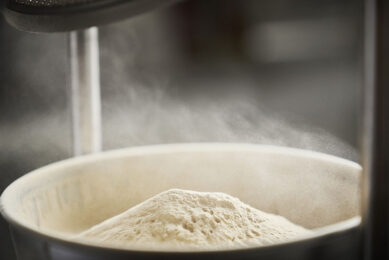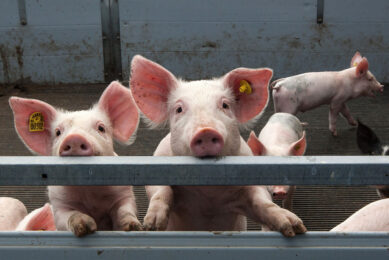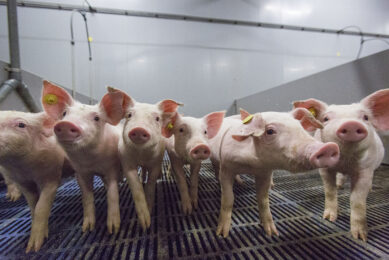Cow immunity boosted with trace minerals
In order to respond to a foreign antigen or a vaccine, a cow must have an immune system that is responsive and capable. In this article we review how trace minerals can help boost these defence mechanisms of ruminants.
Corporation, USA
Trace minerals play critical roles in the development and function of the
immune system. It is,
therefore, imperative that trace mineral status be
maintained to insure sufficient stores are available for optimal animal
performance or when animals become diseased or stressed.
Zinc for better skin
Zinc has a critical role in
maintaining the health and integrity of skin due to its role in cellular repair
and replacement, all keys to the natural defence mechanisms of the mammary
gland. The type of zinc is also important. Cornell University research indicated
that cows challenged with Streptococcus agalactiae recovered faster when
supplemented with complexed (bioavalable) zinc versus ordinary zinc
sources as indicated by lower somatic cell counts. Research conducted
in
Germany showed cows fed complexed zinc during the dry period and into
early lactation had numerically lower SCC and lower lactate dehydrogenase
activity (a measure for mastitis) than cows similarly supplemented with only
inorganic zinc. A study conducted in 2004 showed that feeding a combination of
complexed and inorganic zinc reduced SCC by an average of 33% (98,000 cells/mL)
while increasing milk production 1.3 kg/d (Figure 1). An additional
mode of
action for zinc in improving mammary health is related to its role in
keratin formation (Moynahan, 1981). Keratin is a wax-like substance secreted
into the teat-end orifice or opening. The keratin lining of the teat canal
entraps bacteria and prevents their upward movement into the mammary gland
through its bactericidal properties.
Strong effects of copper
Like zinc, copper is considered
to have strong effects on the immune system. Copper is active in neutrophil
production and affects phagocyte killing ability. Copper is required for
antibody development and lymphocyte replication. Copper, in combination with
zinc, plays a role in superoxide dismutase activity and the removal of oxygen
free radicals. It is therefore a key component in the protective mechanism of
cellular membranes against superoxide free radical damage. In addition to
superoxide dismutase, the copper containing enzyme, ceruloplasmin has been shown
to exhibit anti-inflammatory activity, which may prove beneficial when mastitis
occurs. Cattle suffering from a marginal copper deficiency will have reduced
growth rates and reduced feed efficiencies. They will also have reduced
fertility (male and female) and increased incidences of retained placentas.
Workers at the University of Kentucky reported heifers supplemented with 20 ppm
copper from copper sulphate had lower bacterial counts, SCC and peak rectal
temperatures following exposure to an E. coli challenge than control animals
supplemented with 6 to 7 ppm copper. Research at Texas A&M showed
severely
copper-deficient late gestation beef cows supplemented with complex
copper responded with lower colostrum SCC than non-supplemented cows (Figure
2).
Limited knowledge on manganese
Similar to zinc and
copper, manganese plays an important role in removing superoxide radicals (free
radicals) from the body. However, evidence that manganese plays a major role in
immunological function is limited. Increasing manganese has been shown
to
enhance the killing ability of macrophages via increased enzymatic
activity within non-specific immunity.
Iodine and metabolism
Iodine is required for the
synthesis of the thyroid hormone, thyroxin, which regulates the rate of
metabolism (NRC, 2001). Among the signs of subclinical iodine deficiency is a
suppressed immune system resulting in increased incidences of foot rot and
respiratory diseases. There have been several studies conducted that show a
benefit of feeding iodine in the form of ethylenediamine dihydriodide (EDDI) in
excess of the nutritional requirement to prevent foot
rot. Only 8.3% of
calves on pasture fed a salt mixture containing EDDI had foot rot, while 20.8%
of calves receiving a salt mixture without EDDI had foot rot. When cattle were
inoculated intradermally in the interdigital space with a mixture of
Fusobacterium necrophorum and Bacteriodes melaningenicus to induce acute foot
rot, cattle receiving 12.5-200 mg/head/ day of EDDI had less lameness than
control cattle.
Role of iron
Iron is a necessary component of hemoglobin
and myoglobin for oxygen transport and cellular use. Iron also has a role in
energy metabolism as it facilitates transfer of electrons in the
electron
transport chain for the formation of ATP. Iron supplementation is
usually not needed in ruminant
diets due to the high iron content of many
feedstuffs and soil contamination of many feedstuffs that are ingested by
cattle. Recent changes in meat and bone meal and phosphorus supplementation have
greatly reduced the amount of background iron normally provided in dairy diets.
However, field reports are beginning to indicate increased incidences of dairy
cows suffering from anaemia around calving.
Antioxidant properties of selenium
The interaction of
selenium and immune function focuses around the selenoprotein, glutathione
peroxidase. Glutothione peroxidase inactivates oxygen radicals such as hydrogen
peroxide and prevents them from causing cellular damage. Research by Reffett et
al. (1988) indicated that selenium deficiënt calves had lower serum IgM (an
antibody produced by B cells) concentrations and anti-IBRV titers when
challenged with infectious bovine rhinotrachetis virus than selenium adequate
calves. Weiss reported that supplementing dairy cattle with adequate levels of
selenium (0.3 ppm of dry matter) reduced the prevalence, severity and duration
of mastitis as well
as SCC (2005). In addition, this report suggested organic
forms of selenium have little benefit over inorganic sources, but warrant
further investigation.
Chromium boosts growth
Chromium promotes insulin action,
resulting in increased uptake of glucose and amino acids by cells in the body.
Signs of a chromium deficiency include reduced growth rate, reduced feed
efficiency and reduced immune function. A chromium deficiency in cattle may
result in increased incidences of ketosis, decreased milk production, decreased
feed efficiency and suppressed immune response. Research has shown that chromium
supplementation may help alleviate the effect of stress on the animal. Feeding
200 to 1000 ppb of supplemental chromium from
organic sources to newly
arrived beef cattle in the feedlot reduced serum blood cortisol levels by 40 to
60%. Chromium supplementation during the calving period may help improve the
immune function, reducing the incidence of disease and metabolic disorders that
accompany immune suppression.
Assessing trace mineral status
Trace mineral status is
not static, fluctuating throughout the lifecycle of an animal. Research at the
University of Minnesota indicates that zinc, manganese and copper status, as
measured by concentration in the liver, are lowest in late gestation and early
lactation. In order to gain a better understanding of trace mineral status, body
tissues (i.e. blood, liver, etc.) may be sampled. However, trace mineral content
of some tissues may not be reflective of trace mineral status
of the animal
and may result in erroneous conclusions. While blood is a suitable tissue to
sample and to assess iodine, iron (saturation of iron binding proteins, non-heme
iron) and selenium status in cattle, it is an inappropriate tissue to sample and
to assess copper, zinc, and manganese status. Liver is a better indicator of
manganese, copper and selenium status than blood. Liver cobalt can be used to
indirectly assess an animal’s vitamin B12 status, yet results must be
interpreted with caution. Zinc and copper concentration in liver are a better
indicator of the mineral status than serum or plasma zinc or copper
concentration.
Trace mineral recommendations
For nutritionists balancing
trace mineral levels in livestock rations, the following steps are
suggested:
1) Identify specific mineral needs of the animals. Theactual
mineral requirement will depend upon stage of growth, production rate,
metabolism and mineral concentration in the ration. 2) Determine a realistic
requirement for each trace mineral, taking into consideration the presence of
antagonists in the diet. 3) Because trace mineral bioavailabilities vary with
different chemical forms and diets, evaluate available research and determine
what is the most consistent
and predictable product on the market that suits
the animals’ needs and the producer’s performance expectations. Table 1 lists
the current recommendations from Zinpro Corporation.
Conclusion
Balancing rations for today’s high performance
dairy cattle require that we not only deliver proper amounts of amino acids,
energy, carbohydrates and fat, but that we also balance rations to deliver the
proper amounts of trace minerals in forms that an animal can utilise. Trace
minerals are key components in the normal functionality of the immune system and
are therefore critical to maintenance of immune competence for optimal animal
performance.
• This article has been edited from its original form, presented at
the latest AFMA congress in South Africa.











